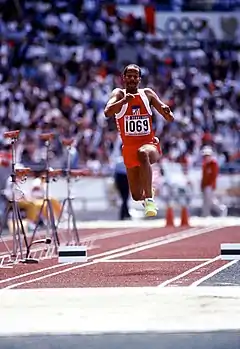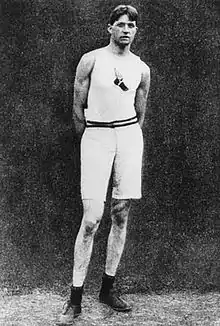Triple jump at the Olympics
The triple jump at the Summer Olympics is grouped among the four track and field jumping events held at the multi-sport event. The men's triple jump has been present on the Olympic athletics programme since the first Summer Olympics in 1896. The women's triple jump is one of the more recent additions to the programme, having been first contested in 1996. It became the third Olympic jumping event for women after the high jump and long jump.
| Triple jump at the Olympic Games | |
|---|---|
 Willie Banks in the 1988 Olympic triple jump competition | |
| Overview | |
| Sport | Athletics |
| Gender | Men and women |
| Years held | Men: 1896 – 2016 Women: 1996 – 2016 |
| Olympic record | |
| Men | 18.09 m Kenny Harrison (1996) |
| Women | 15.39 m Françoise Mbango Etone (2008) |
| Reigning champion | |
| Men | |
| Women | |
The Olympic records for the event are 18.09 m (59 ft 4 in) for men, set by Kenny Harrison in 1996, and 15.39 m (50 ft 5 3⁄4 in) for women, set by Françoise Mbango Etone in 2008. The men's triple jump world record was broken at the competition in 1924, 1932, 1936, 1956 and 1968. At the 1968 Summer Olympics, three men improved the record a total of five times at the high altitude of Mexico City.[1] The women's world record has never been broken at the Olympics and the current mark of 15.50 m (50 ft 10 in), set in 1995, pre-dates the first Olympic event.[2]
James Brendan Connolly was the first Olympic triple jump champion and, as it was the first event to conclude in 1896, he was also the first Olympic champion of the modern era.[3] Inessa Kravets, the world record holder, became the first women's champion 100 years later. American Christian Taylor and Colombian Caterine Ibargüen are the reigning Olympic champions from 2016.
Viktor Saneyev is the event's most successful athlete as he was Olympic champion three times consecutively from 1968 to 1976, as well as runner-up in 1980. Françoise Mbango Etone is the only woman to win two Olympic triple jump titles. Saneyev, Vilho Tuulos and Tatyana Lebedeva are the only three athletes to have won more than two Olympic medals in the event. The United States is the most successful nation in the event, with eight gold medals to its name. The Soviet Union is the next most successful, with four golds.
A short-lived standing triple jump variant of the event was contested in 1900 and 1904 and standing jumps specialist Ray Ewry won both gold medals.
Medalists
Men
Multiple medalists
| Rank | Athlete | Nation | Olympics | Gold | Silver | Bronze | Total |
|---|---|---|---|---|---|---|---|
| 1 | Viktor Saneyev | 1968–1980 | 3 | 1 | 0 | 4 | |
| 2 | Myer Prinstein | 1900–1904 | 2 | 0 | 0 | 2 | |
| Adhemar da Silva | 1952–1956 | 2 | 0 | 0 | 2 | ||
| Józef Szmidt | 1960–1964 | 2 | 0 | 0 | 2 | ||
| Christian Taylor | 2012–2016 | 2 | 0 | 0 | 2 | ||
| 6 | James Brendan Connolly | 1896–1900 | 1 | 1 | 0 | 2 | |
| Mike Conley, Sr. | 1984–1992 | 1 | 1 | 0 | 2 | ||
| Jonathan Edwards | 1996–2000 | 1 | 1 | 0 | 2 | ||
| 9 | Vilho Tuulos | 1920–1928 | 1 | 0 | 2 | 3 | |
| 10 | Will Claye | 2012–2016 | 0 | 2 | 0 | 2 | |
| 11 | Nelson Prudencio | 1968–1972 | 0 | 1 | 1 | 2 | |
| 12 | Erik Almlöf | 1912–1920 | 0 | 0 | 2 | 2 | |
| Vitold Kreyer | 1956–1960 | 0 | 0 | 2 | 2 | ||
| João Carlos de Oliveira | 1976–1980 | 0 | 0 | 2 | 2 |
Medalists by country
| Rank | Nation | Gold | Silver | Bronze | Total |
|---|---|---|---|---|---|
| 1 | 8 | 8 | 2 | 18 | |
| 2 | 4 | 5 | 4 | 13 | |
| 3 | 3 | 3 | 2 | 8 | |
| 4 | 3 | 1 | 1 | 5 | |
| 5 | 2 | 2 | 1 | 5 | |
| 6 | 2 | 1 | 3 | 6 | |
| 7 | 2 | 0 | 0 | 2 | |
| 8 | 1 | 1 | 1 | 3 | |
| 9 | 1 | 0 | 2 | 3 | |
| 10 | 1 | 0 | 0 | 1 | |
| 1 | 0 | 0 | 1 | ||
| 12 | 0 | 1 | 1 | 2 | |
| 13 | 0 | 1 | 0 | 1 | |
| 0 | 1 | 0 | 1 | ||
| 0 | 1 | 0 | 1 | ||
| 0 | 1 | 0 | 1 | ||
| 0 | 1 | 0 | 1 | ||
| 0 | 1 | 0 | 1 | ||
| 19 | 0 | 0 | 2 | 2 | |
| 0 | 0 | 2 | 2 | ||
| 0 | 0 | 2 | 2 | ||
| 22 | 0 | 0 | 1 | 1 | |
| 0 | 0 | 1 | 1 | ||
| 0 | 0 | 1 | 1 | ||
| 0 | 0 | 1 | 1 | ||
| 0 | 0 | 1 | 1 | ||
Women
Multiple medalists
| Rank | Athlete | Nation | Olympics | Gold | Silver | Bronze | Total |
|---|---|---|---|---|---|---|---|
| 1 | Françoise Mbango Etone | 2004–2008 | 2 | 0 | 0 | 2 | |
| 2 | Olga Rypakova | 2008–2016 | 1 | 1 | 1 | 3 | |
| 3 | Caterine Ibargüen | 2012–2016 | 1 | 1 | 0 | 2 | |
| 4 | Tatyana Lebedeva | 2000–2008 | 0 | 1 | 1 | 2 | |
Medalists by country
| Rank | Nation | Gold | Silver | Bronze | Total |
|---|---|---|---|---|---|
| 1 | 2 | 0 | 0 | 2 | |
| 2 | 1 | 1 | 1 | 3 | |
| 3 | 1 | 0 | 2 | 3 | |
| 4 | 1 | 1 | 0 | 2 | |
| 5 | 1 | 0 | 0 | 1 | |
| 6 | 0 | 2 | 1 | 3 | |
| 7 | 0 | 1 | 0 | 1 | |
| 8 | 0 | 1 | 0 | 1 | |
| 9 | 0 | 0 | 1 | 1 | |
| 10 | 0 | 0 | 1 | 1 |
Standing triple jump
| Standing triple jump at the Olympic Games | |
|---|---|
 Ray Ewry at the 1900 Summer Olympics | |
| Overview | |
| Sport | Athletics |
| Gender | Men |
| Years held | Men: 1900 – 1904 |
| Olympic record | |
| Men | 10.58 m Ray Ewry (1900) |
In 1900 and 1904 a variation of the event was contested at the Olympics where athletes had to triple jump from a standing position. This was one of three standing jumps to have featured on the Olympic programme, alongside the standing high jump and the standing long jump (both running from 1900 to 1912).[4]
The standing jump competitions were dominated by Ray Ewry, who won the 1900 Olympic standing triple jump title and defended it four years later. His clearance of 10.58 m (34 ft 8 1⁄2 in) to win the inaugural competition went unbettered as the Olympic record for the event. Ewry took Olympic three gold medals in standing jumps in both 1900 and 1904, then won the standing high and long jumps at the 1908 Olympics, as well as the 1906 Intercalated Games.[5]
Standing jump events had been a relatively common type of athletics event at the end of the 19th century, but became increasingly rare at top level national and international competitions as the 20th century progressed.[5] The standing triple jump was the least common of the standing jumps and the Olympics remains the only major international competition to have featured the event.
| Games | Gold | Silver | Bronze |
|---|---|---|---|
| 1900 Paris |
|||
| 1904 St. Louis |
References
- Participation and athlete data
- Athletics Men's Triple Jump Medalists. Sports Reference. Retrieved on 2014-05-03.
- Athletics Women's Triple Jump Medalists. Sports Reference. Retrieved on 2014-05-03.
- Olympic record progressions
- Mallon, Bill (2012). TRACK & FIELD ATHLETICS - OLYMPIC RECORD PROGRESSIONS. Track and Field News. Retrieved on 2014-05-03.
- Specific
- Athletics at the 1968 Ciudad de México Summer Games: Men's Triple Jump. Sports Reference. Retrieved on 2014-05-11.
- 12th IAAF World Championships In Athletics: IAAF Statistics Handbook Berlin 2009 (pgs. 546, 556, 646). IAAF (2009). Retrieved on 2014-05-03.
- James B. Connolly. Sports Reference. Retrieved on 2014-05-11.
- Athletics Men's Standing Triple Jump Medalists. Sports Reference. Retrieved on 2014-05-07.
- Ray Ewry. Sports Reference. Retrieved on 2014-05-07.
External links
- IAAF triple jump homepage
- Official Olympics website
- Olympic athletics records from Track & Field News